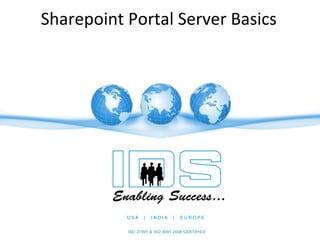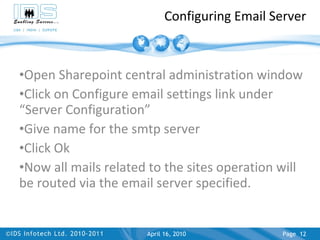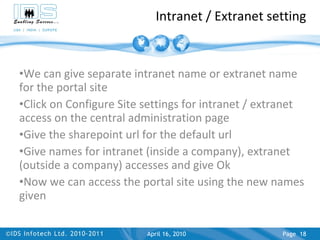Fundamentals of Microsoft Sharepoint
- 1. Sharepoint Portal Server Basics
- 2. Introduction Sharepoint server belongs to Microsoft family of servers Integrated suite of server capabilities Hosted Application ŌĆō i.e. runs on a windows server O/S Support for Intranet, extranet access available Improves organizational effectiveness by sharing information, content management April 17, 2010 Page
- 3. Beneficiaries of Sharepoint Business Manager Can access contents (files) that are confidential from remote place if provided with proper credentials Minimizes operation cycle time and travel time IT Professional High availability, security of artifacts Simplicity in accessing contents End user Alerts through email Dash boards to compare results Message boards to discuss matters April 17, 2010 Page
- 4. Architecture April 17, 2010 Page
- 5. Creating a Top level site Follow these steps to create a top level site Open IIS and create a virtual directory and assign a port number other than 80 (as it will be used by http request) In the sharepoint administration, click on ŌĆ£Extend Virtual ServerŌĆØ under server administration, click Ok in the new page that was opened after giving administrator details, sharepoint server details Click on ŌĆ£Create Content dbŌĆØ under server administration. In the landing page click ok, after selecting server and db. April 17, 2010 Page
- 6. Top level site ŌĆō contdŌĆ” Select the virtual server that was created (virtual directory port will be listed) Give a name for the site and click OK The url for the site will be displayed Click on the url. A new window will be opened with the template selection screen Select a template for the site and give OK April 17, 2010 Page
- 7. Logging in to a sharepoint site April 17, 2010 Page
- 8. Managing Users Add the users to the sharepoint portal group Go to Computer Management Select users and groups Under groups, select Sharepoint user group and right click on it to add new user. In the new user dialog box, give the user details as DomainName\UserName and press OK. That user will be associated to the group We can also create local users in the computer and make them access sharepoint April 17, 2010 Page
- 9. Users (Contd..) Log in to the sharepoint site ŌĆō http://servername:portnumber/site/default.aspx as an administrator Navigate to Settings tab in the top of the site Click on Manage Users Click on Add Users and give the user details, email Id, select the sharepoint group to which the user will be associated and click Ok. Email will be sent to the user along with the link to the sharepoint site April 17, 2010 Page
- 10. Managing Groups Users can be assigned to the default groups present in sharepoint Administrator : Has overall control of the site Contributor : Can contribute items for the site Web Designer : Can add new pages Reader : Can only view the contents We can also add new groups and assign access rights for the groups Click on Manage groups in the Settings page and click on Add New Group to add new group April 17, 2010 Page
- 11. Creating Sub sites To add a new sub site, click on the ŌĆ£CreateŌĆØ link Click on ŌĆ£SitesŌĆØ link on the page Give a name for the sub site and click OK Choose a template for the site and the new site will open up Go to Site administration page and click on add users Enter user detail and associate the user with the Administrator group April 17, 2010 Page
- 12. Configuring Email Server Open Sharepoint central administration window Click on Configure email settings link under ŌĆ£Server ConfigurationŌĆØ Give name for the smtp server Click Ok Now all mails related to the sites operation will be routed via the email server specified. April 17, 2010 Page
- 13. Databases used Configuration DB: This is the database that contains all configuration information related to the server database connection etc Content DB: This database contains the sites, subsites data For each site a new content db is created Component Services DB: This contains details regarding the sharepoint services like alerts, messages, site quota, content db details etc April 17, 2010 Page
- 14. Creating Site Templates Choose a sharepoint site that we need to save as a template Go to Site Administration page Click on ŌĆ£Save Site as TemplateŌĆØ link It will ask a name for the template and an option to save the data of the site page too. Give a name for the template The site will be saved as a template and can be used while creating a new sharepoint site April 17, 2010 Page
- 15. Viewing Statistics In the site administration page, we have options for Viewing site usage Who have accessed the site When the site has been accessed How many hits have been there for this site Viewing site quota How much space available for a site How many users can be created for a site How many users have been added How many space has been used, by which module etc April 17, 2010 Page
- 16. Web Parts Web parts enhance the siteŌĆÖs functionality They are all additional component that can be added to the site We can add custom parts to the site Custom parts can be created using visual studio and they can be saved as dwp files Search, Browse, Upload are few of the available web parts They can be added by administrator, using Site Settings -> Add Web Parts link April 17, 2010 Page
- 17. Anonymous Access Go to Sharepoint administration console Click on Anonymous Access setting Give the portal name for which anonymous access need to be given Check the Allow Anonymous Access check box and give OK We need to be careful before giving anonymous access as anyone will be able to crawl through the site content April 17, 2010 Page
- 18. Intranet / Extranet setting We can give separate intranet name or extranet name for the portal site Click on Configure Site settings for intranet / extranet access on the central administration page Give the sharepoint url for the default url Give names for intranet (inside a company), extranet (outside a company) accesses and give Ok Now we can access the portal site using the new names given April 17, 2010 Page
- 19. Back up and Restore There is a sharepoint Back Up ŌĆō Restore utility that allows us to take back up of a sharepoint database, portal site and restore the same in another machine or in the same machine in case of any calamity This is for disaster recovery April 17, 2010 Page
- 20. April 17, 2010 Page
- 21. Back Up The available components are listed and we can select a component and take a back up. Back up will create two files ŌĆō XML configuration file that tells about the server from which back up was taken, status of the operation etc Back up file with an extension SPB (Share Point Backup) that has the data April 17, 2010 Page
- 22. April 17, 2010 Page
- 23. Restore Available components that are ready for restore will be listed We need to mention a configuration file (XML file) to restore Once the information about XML file is given and component for restore is selected, restore will begin The status will be communicated to the administrator April 17, 2010 Page
- 24. Back up / Restore Command line utility The following tool comes along with sharepoint They are located in the bin folder in the path where sharepoint is installed Spsbackup : takes back up of all sites and dbs Spsadm : takes back up of windows sharepoint service site collections Smigrate : migration and upgradation tool used for migrating database or portal site from one system to another or from one version to another April 17, 2010 Page
- 25. Third Party Recovery tool Veritas ŌĆō Back Up Exec10.0 Sharepoint server level back up CA ŌĆō Brightstor ARC Serve Back Up Back up and restore of sharepoint db hosted on various SQL server across enterprise Advanced document level back up and restore support Ave Point ŌĆō DocAve Item level back up and restore CommVault ŌĆō GA ŌĆō Galaxy SPS 2003 DB level backup and recovery Webstore back up and support April 17, 2010 Page
- 26. Please feel free to have us contacted: Abhishek Kapoor IDS Infotech Email:abhishek.k@idsil.com www.idsil.com Q & A || Contact Us April 17, 2010 Page


























